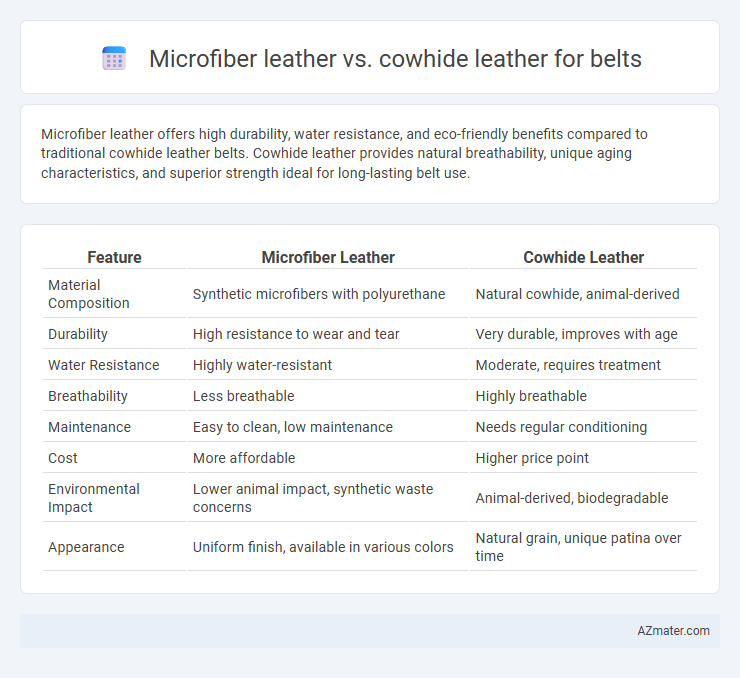Microfiber leather offers high durability, water resistance, and eco-friendly benefits compared to traditional cowhide leather belts. Cowhide leather provides natural breathability, unique aging characteristics, and superior strength ideal for long-lasting belt use.
Table of Comparison
| Feature | Microfiber Leather | Cowhide Leather |
|---|---|---|
| Material Composition | Synthetic microfibers with polyurethane | Natural cowhide, animal-derived |
| Durability | High resistance to wear and tear | Very durable, improves with age |
| Water Resistance | Highly water-resistant | Moderate, requires treatment |
| Breathability | Less breathable | Highly breathable |
| Maintenance | Easy to clean, low maintenance | Needs regular conditioning |
| Cost | More affordable | Higher price point |
| Environmental Impact | Lower animal impact, synthetic waste concerns | Animal-derived, biodegradable |
| Appearance | Uniform finish, available in various colors | Natural grain, unique patina over time |
Introduction to Microfiber Leather and Cowhide Leather
Microfiber leather is a synthetic material crafted from ultra-fine polyester fibers combined with polyurethane, offering high durability, water resistance, and a sustainable alternative to animal-based products. Cowhide leather, derived from the split hide of cows, is renowned for its natural grain, strength, breathability, and ability to develop a unique patina over time. Both materials serve different purposes in belt production, with microfiber leather emphasizing eco-friendliness and affordability, while cowhide leather highlights traditional craftsmanship and long-lasting quality.
Composition and Manufacturing Process
Microfiber leather consists of a synthetic resin and ultra-fine microfiber fabric, created through a process that involves bonding these components with heat and pressure to mimic the texture and durability of animal leather. Cowhide leather is made from the tanned hide of cows, undergoing processes like chrome tanning or vegetable tanning, which stabilize the collagen fibers for strength and flexibility. The manufacturing of microfiber leather allows for consistent quality and environmental control, while cowhide leather offers natural breathability and develops a unique patina over time.
Appearance and Texture Comparison
Microfiber leather exhibits a consistent, smooth appearance with a uniform grain pattern that mimics genuine leather, while cowhide leather features natural variations and unique markings that enhance its authentic look. The texture of microfiber leather feels supple and slightly synthetic, offering a lightweight and flexible experience; in contrast, cowhide leather provides a firm yet soft texture with a rich, tactile grain that develops character over time. Both materials offer distinct visual and tactile qualities, making microfiber leather ideal for a modern, uniform aesthetic and cowhide leather preferable for a traditional, rugged belt style.
Durability and Wear Resistance
Microfiber leather offers superior durability and wear resistance compared to traditional cowhide leather, as it resists cracking, peeling, and stains more effectively due to its synthetic fiber composition. Cowhide leather, while strong and natural, tends to develop creases, scuffs, and patina over time, which can affect its longevity under frequent use. For belt applications requiring long-lasting performance and minimal maintenance, microfiber leather provides enhanced abrasion resistance and color retention.
Flexibility and Comfort in Daily Use
Microfiber leather offers superior flexibility compared to traditional cowhide leather, allowing belts to mold comfortably to the wearer's body over time without cracking or deforming. Cowhide leather, while durable and strong, tends to be stiffer initially and may require a break-in period before reaching optimal comfort. For daily use, microfiber leather belts provide enhanced comfort due to their breathable, lightweight nature and ability to maintain flexibility under frequent bending and movement.
Water and Stain Resistance
Microfiber leather offers superior water and stain resistance compared to cowhide leather, making it highly durable and low-maintenance for belts exposed to moisture and dirt. Its synthetic fibers create a dense, non-porous surface that prevents water absorption and repels stains effectively. In contrast, cowhide leather requires regular conditioning to maintain its water resistance, as it is more prone to water damage and staining over time.
Eco-Friendliness and Sustainability
Microfiber leather offers enhanced eco-friendliness compared to cowhide leather due to its lower water consumption and absence of harmful chemicals during production. Cowhide leather, derived from animal hides, involves significant environmental impacts including deforestation, methane emissions, and extensive water use in tanning. Choosing microfiber leather for belts supports sustainability by reducing reliance on animal agriculture and minimizing carbon footprint while maintaining durability and aesthetic appeal.
Maintenance and Cleaning Requirements
Microfiber leather belts require minimal maintenance, needing only regular wiping with a damp cloth and occasional use of mild soap to remove surface dirt without damaging the material. Cowhide leather belts demand more intensive care, including conditioning with leather oils or creams to prevent drying and cracking, along with careful cleaning using leather-specific products to maintain suppleness and appearance. Moisture exposure should be avoided for both, but cowhide leather is particularly sensitive to water, making microfiber leather a more practical choice for low-maintenance belt care.
Price and Value for Money
Microfiber leather belts typically cost 30-50% less than cowhide leather belts while offering excellent durability and water resistance. Cowhide leather belts provide a classic, long-lasting finish that improves with age, often justifying their higher price for those valuing premium quality and traditional craftsmanship. For budget-conscious buyers seeking style and performance, microfiber leather belts deliver superior value for money without sacrificing appearance.
Which Leather is Best for Belts?
Microfiber leather offers superior water resistance and durability compared to traditional cowhide leather, making it an excellent choice for belts intended for everyday use and exposure to moisture. Cowhide leather, prized for its natural texture and breathability, provides unmatched comfort and a classic aesthetic that develops a unique patina over time. Choosing between microfiber and cowhide leather for belts depends on whether longevity and maintenance-free wear or authentic leather look and feel are your primary priorities.

Infographic: Microfiber leather vs Cowhide leather for Belt
 azmater.com
azmater.com